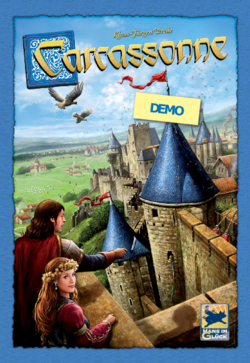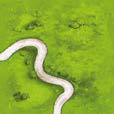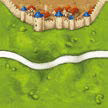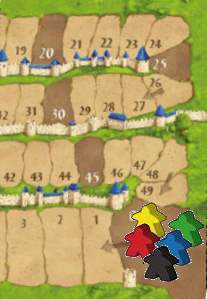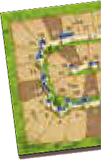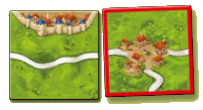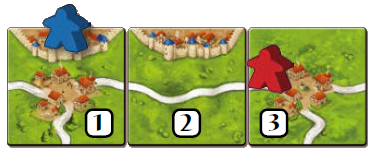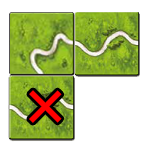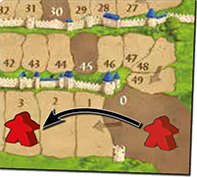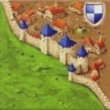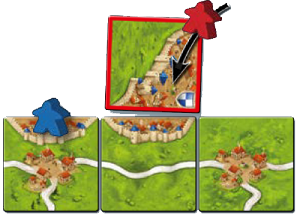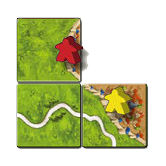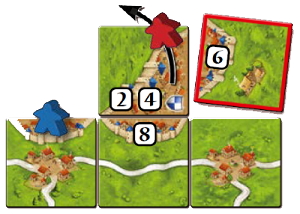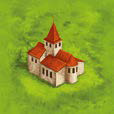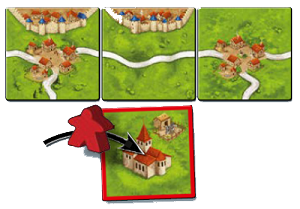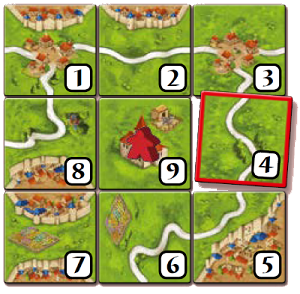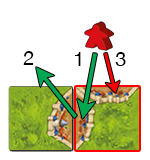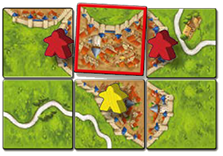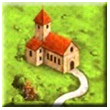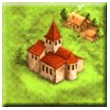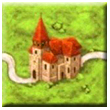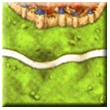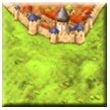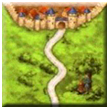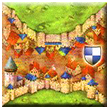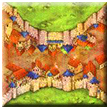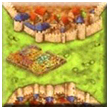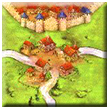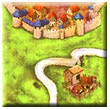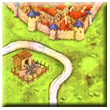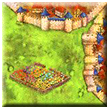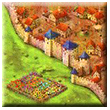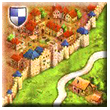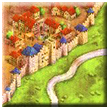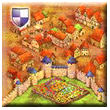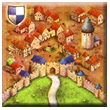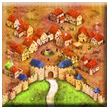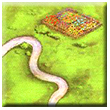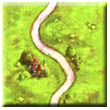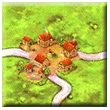Afdrukken-en-Spelen Demo
Algemene informatie en opmerkingen
Oorspronkelijk in 2020 uitgegeven door Hans im Glück.
Het is een gratis afdrukken-en-spelen demo-spel:
- Druk de tegels die in de PDF met de spelregels opgenomen zijn (zie de links hieronder) af op dik papier, of plak de afdrukken op karton en snij ze voorzichtig uit.
- Je gaat speelstukken in verschillende kleuren nodig hebben. Elke speler heeft 5 speelstukken van dezelfde kleur nodig. Het oorspronkelijke spel bevat deze kleine houten pionnen die we "meeples" noemen.
- Je kunt ook een scoretableau maken (ook opgenomen in de PDF met de spelregels) waarop je de punten tijdens het spel kunt aangeven. Om het scoretableau te kunnen gebruiken heb je nog een speelstuk in elke spelerskleur nodig. Je kunt de punten ook op papier bijhouden.
- Dit demo-spel heeft minder (48 in plaats van 72) en kleinere tegels. Het wordt ook met minder meeples (5 in plaats van 7) gespeeld dan het oorspronkelijke Carcassonne. De spelregels zijn verder hetzelfde en staan hieronder.
- In het basisspel zijn ook spelregels voor gevorderde spelers en 2 mini-uitbreidingen opgenomen.
De tegels en het scoretableau staan op pagina 2 tot 4 van het boekje met de spelregels dat hier verkrijgbaar is:
- Engelstalige versie:
- Duitstalige versie:
De tegelverdeling is hetzelfde als bij Carcassonne voor 2.
Speelmateriaal en voorbereiding
Het volgende deel zal de eerste opzet uitleggen en alle onderdelen van het spel introduceren.
Er zijn 48 landtegels met afbeeldingen van wegen, steden en kloosters, die allemaal in een weide liggen.
Elke tegel met uitzondering van de starttegel heeft dezelfde achterkant en die zou je op de achterkant moeten markeren om het gemakkelijk te maken die opzij te leggen.
Leg de starttegel (de tegel die je gemarkeerd hebt) in het midden van de tafel. Schud de overgebleven tegels en leg deze als gedekte stapels op tafel, zodat ze voor iedereen makkelijk te pakken zijn. Het is ook mogelijk om de tegels in een zak of de doos te doen en ze hieruit blind te pakken.
Dan komt het scoretableau, deze leg je aan de zijkant van je speelveld.
Tenslotte, zijn daar de meeples. Voor dit spel heb je voor elke speler 5 speelstukken van dezelfde kleur nodig. Je hebt ook 1 speelstuk extra nodig voor elke speler dat je op veld 0 van het scoretableau zet.
| Meeples |
Overzicht en doel van het spel
In Carcassonne leggen spelers om de beurt tegels en breiden hierdoor het landschap uit met wegen, steden, kloosters en weiden, met één tegel per keer. Spelers hebben de keuze om hun meeples op de tegel te plaatsen, dit kan op een van de individuele projecten (wegen, steden, kloosters of weiden), waar ze een struikrover, ridder of monnik worden. Punten worden door het spel heen verdiend en de speler die na de eindtelling de meeste punten heeft is de winnaar!
Spelverloop
Carcassonne wordt met de klok mee gespeeld. Het spel begint met de jongste speler [1], de speler die aan de beurt is voert de volgende acties in de aangegeven volgorde uit, waarna de volgende speler aan de beurt is, enzovoort. Eerst geven we een korte beschrijving gegeven van de acties die je tijdens je beurt moet doen. Deze acties worden gedetailleerder als we de wegen, steden en uiteindelijk de kloosters hebben uitgelegd. Wat zijn deze acties?
1. Landtegel leggen
| De speler moet precies 1 landtegel van een stapel trekken en die rechtop aan een reeds op het speelveld liggende tegel aanleggen en het landschap uitbreiden. [2] |
De wegen
1. Landtegel leggen
Je trekt de afgebeelde tegel met drie wegdelen die bij een dorp beginnen. Je moet die zo aanleggen dat het bestaande landschap (de tegels die er al liggen) wordt voortgezet. In het zeldzame geval dat de tegel niet op een geldige manier kan worden aangelegd, en alle spelers het daarover eens zijn, wordt deze uit het spel verwijderd en trekt de speler een andere tegel. [3]
2. Een meeple als struikrover zetten
Na het aanleggen van de tegel, mag je een meeple als struikrover op één van de wegdelen van die tegel zetten, maar alleen als de weg niet bezet is door een andere struikrover.
In ons voorbeeld vindt er nog geen puntentelling plaats (zie actie 3), aangezien de weg nog niet afgebouwd is, en is de volgende speler nu aan de beurt.
De volgende speler trekt een tegel die hij/zij aanlegt om het landschap uit te breiden. Ze mag geen meeple op de weg naar rechts plaatsen, omdat er al een struikrover op die weg staat. In plaats daarvan kiest ze ervoor om haar meeple als ridder op het stadsdeel van die tegel te zetten.
3. Punten tellen voor een weg
Als beide zijden van een weg afgesloten zijn, is die weg afgebouwd en wordt geteld. Een uiteinde van een weg is afgesloten als die in een dorp, [4] een stad, of klooster eindigt, of een lus vormt met zichzelf.
Hoewel je tegenstander de tegel heeft aangelegd, wordt hiermee ook jouw weg afgebouwd. Hoeveel punten krijg je? Bij het tellen van de punten voor een weg krijg je voor elke tegel waaruit de weg bestaat 1 punt. In dit voorbeeld bestaat de weg uit 3 tegels, daarvoor krijg je 3 punten.
Nu is het tijd om je punten te noteren. Hoeveel punten je hebt wordt bijgehouden met de meeple die je voor aanvang van het spel op het scoretableau hebt gezet. In ons voorbeeld, zet je die 3 velden vooruit om aan te geven dat je 3 punten hebt gekregen. Opmerking: als je meer dan 50 punten hebt verzameld, leg je je telmeeple plat neer om aan te geven dat je meer dan 50 punten hebt.
Na elke puntentelling, neem je de meeple die bij de puntentelling betrokken was terug in voorraad.
We hebben de belangrijkste delen van het spel al gezien. Nu zullen we dieper ingaan op die acties door te laten zien hoe ze van toepassing zijn op de andere projecten, namelijk steden en kloosters.
De steden
2. Een meeple als ridder zetten
Vervolgens kijk je of er al een meeple als ridder op de stad staat. Dat is hier niet het geval, dus kun je een van jouw meeples als ridder op deze stad zetten.
3. Scoring a city
Let's continue our example and assume that a few turns have passed. You now draw this tile that you place to continue your city. Since the tile you’ve placed completes a feature (here, the city), it must now be scored. A city is completed when it is surrounded by walls and there are no gaps inside the city. Since you have a meeple in the completed city, you are the player to score it.
Each tile in a completed city is worth 2 points. In addition, each coat of arms is worth 2 more points. [5] For this city, you score 8 points. As usual, the meeple that was in the scored feature returns to your supply.
The monasteries
1. Placing a tile
Once more, you draw a tile to continue the landscape. Monasteries are always depicted in the center of a tile. When placing such a tile, you must, as usual, make sure that it continues the illustration. [6]
3. Scoring a monastery
A monastery is completed when it is surrounded by tiles. During scoring, the monastery is worth 1 point per tile that completes it (including the monastery itself).
By placing this tile, you complete your monastery. It earns you 9 points and allows you to take your meeple back.
Summary
1. Placing a tile
- You must place your drawn tile in such a way that it continues the landscape and the illustration.
- In some very rare cases, it may be impossible to place the tile. In those cases, simply return the tile to the box and draw a new one.
2. Placing a meeple
- You may place a meeple on the tile you’ve just placed.
- You may not place a meeple in a feature where there already is at least one other meeple, including one of yours.
3. Scoring a feature
- A road is completed when both ends lead to a village, a city, a monastery, or the road forms a loop. Each tile in a completed road is worth 1 point.
- A city is completed when it is surrounded by walls and there are no holes inside the city. Each tile in the completed city is worth 2 points. Each coat of arms in the completed city is worth an extra 2 points.
- A monastery is completed when it is surrounded by 8 tiles. Each of the monastery’s tiles (the 8 surrounding tiles and the one with the monastery itself) is worth 1 point.
- Scoring always occurs at the end of a player’s turn. At that moment, each player with a meeple in a scored feature earns points. [7]
- After each scoring, return to your supply the scored meeples.
- If there are multiple meeples in a single scored feature, the player with the most meeples is awarded full points and all other players receive nothing. When more than one player have the most meeples in a scored feature, the tied players all score full points.
Special cases
Use a meeple, score a feature, and get the meeple back
You can place a meeple in a feature you just completed, immediately score it, and then return the meeple to your supply.
To do so, follow these steps:
__ 1. Place a tile, completing a feature (such as a road, city, or monastery).
__ 2. Place a meeple as a highwayman, knight, or monk on the feature you just completed.
__ 3. Score the completed road, city, or monastery and return the meeple to your supply.
![]() Vraag: There is a situation that puzzles us. If a player draws a tile with two city segments and completes a small city, earning 4 points, can he or she then deploy a meeple to a new city segment in the same turn?
Vraag: There is a situation that puzzles us. If a player draws a tile with two city segments and completes a small city, earning 4 points, can he or she then deploy a meeple to a new city segment in the same turn?
Many meeples on the same road
Many meeples in the same city

Game end and final scoring
The game ends immediately after the turn of the player who placed the last tile. Then, players proceed to a final scoring, after which the winner will be known.
Once the game is over, all meeples still in play are scored:
- Each incomplete road is worth 1 point per tile, just like during the game.
- Each incomplete city is worth 1 point per tile and 1 point per coat of arms, which is only half the points.
- Each incomplete monastery is worth 1 point plus 1 point per adjacent tile, just like during the game.

- Left city: Green is the only one to score 8 points (5 tiles and 3 coat of arms). Black does not score any points since Green has the most meeples in this city.
- Monastery: Yellow scores 4 points for this incomplete monastery (3 points for the adjacent tiles and 1 point for the monastery itself).
- Right city: Blue scores 3 points for this incomplete city (2 tiles and 1 coat of arms).
- Road: Red scores 3 points for this incomplete roads (3 tiles).
Once the final score is known, the winner is the player with the most points.[8]
House rules
- The players decide who starts the game by any method they choose—such as by rolling three meeples. The first player to ‘roll’ a standing meeple decides who plays first. (Thanks to Joff.)
- To determine the first player; each player draws a tile from the bag, the player that drew the tile with the most roads (0 to 4) plays first, if there is a tie for most roads, a draw-off takes place. This is repeated until someone wins. (Thanks to michael.)
- Take your next tile at the end of your turn, to give you time to think about placement and avoid analysis paralysis.
- Play with a three-tile hand. The abbey counts as part of your hand. Play your turn, including the builder, and then draw back up to three tiles. These tiles could be visible to all or hidden to the other players (Thanks to DavidP and youtch.)
- When playing with a bag for the tiles, the original starting tile may be put into the bag, and unplayable tiles can be put back into the bag rather than set to one side. (Thanks to dwhitworth.)
- When a tile is the only tile which can currently complete a structure, other players can offer to ‘buy’ it by offering points, trades counter, abbey, and so on. (Thanks to Deatheux.)
- If you place a tile that fills a hole in the playing field by touching something on all four adjacent sides, you get another turn. This helps motivate people to finish the board even if they do not get an advantage from the placement. (Does not apply to the abbey tile). (Thanks to viberunner.)
- Incomplete features at the end of the game do not score points at the end of the game. (Thanks to metoth.)
- The edge of the table limits the playing area. Thus, a player may not place a tile past the edge of the table or move the playing area to place a tile that would have been past the edge of the table. (Thanks to metoth for prompting this one, and to SkullOne for pointing out that this is an official rule from Hunters and Gatherers.)
- Table borders COMPLETE features as an abbey would. (Thanks to PreGy.)
- Use colored dice instead of meeples on the scoring track. Start out with the 6 showing on top. When the marker completes one lap, turn it to the number 1 to indicate it has completed one lap. This shows at a glance which player is on what lap and who's ahead. On the 100 space track it’s even easier to determine someone’s score at a glance. (Thanks to Carcking.)
Tile distribution
Voetnoten
Kijk op de Pictogrammen pagina voor uitleg over en licensering van de pictogrammen.
- ↑
 Het is gebruikelijk om de startspeler willekeurig te kiezen. Meer hierover is te vinden in het onderdeel huisregels.
Het is gebruikelijk om de startspeler willekeurig te kiezen. Meer hierover is te vinden in het onderdeel huisregels.
- ↑
 Een nieuw aangelegde landtegel moet aan alle zijden bij het aangrenzende terrein passen! Het is bij het aanleggen niet genoeg dat slechts één zijde past.
Een nieuw aangelegde landtegel moet aan alle zijden bij het aangrenzende terrein passen! Het is bij het aanleggen niet genoeg dat slechts één zijde past.
- ↑
 Als de tegels uit een buidel getrokken worden, kan een tegel die niet aangelegd kan worden ook teruggestopt worden in de buidel.
Als de tegels uit een buidel getrokken worden, kan een tegel die niet aangelegd kan worden ook teruggestopt worden in de buidel.
- ↑
 Een dorp is een groepje gebouwen met rode daken rondom de kruising.
Een dorp is een groepje gebouwen met rode daken rondom de kruising.
- ↑
 Note that a coat of arms only affects the city segment it is in, not the whole tile (if there is more than one segment on a single tile).
Note that a coat of arms only affects the city segment it is in, not the whole tile (if there is more than one segment on a single tile).
- ↑
 Monasteries can be placed directly next to each other, or corner to corner. It is not necessary for there to be eight other (non-monastery) tiles neighbouring a monastery. A monastery stands in the middle of a field segment and other segments can be placed next to it. In contrast to roads, cities, and fields, it is not possible to connect to a monastery.
Monasteries can be placed directly next to each other, or corner to corner. It is not necessary for there to be eight other (non-monastery) tiles neighbouring a monastery. A monastery stands in the middle of a field segment and other segments can be placed next to it. In contrast to roads, cities, and fields, it is not possible to connect to a monastery.
- ↑
 When two meeples of one color are occupying the same road or city, you do not score double in these cases. The number of meeples has no effect on the points that a player earns from a road or city. Two knights do not double the points. The number of meeples is only important in establishing who has the majority.
When two meeples of one color are occupying the same road or city, you do not score double in these cases. The number of meeples has no effect on the points that a player earns from a road or city. Two knights do not double the points. The number of meeples is only important in establishing who has the majority.
- ↑
 Rules do not include tiebreakers. That is rules explaining situation when few players share the same score.
Rules do not include tiebreakers. That is rules explaining situation when few players share the same score.
